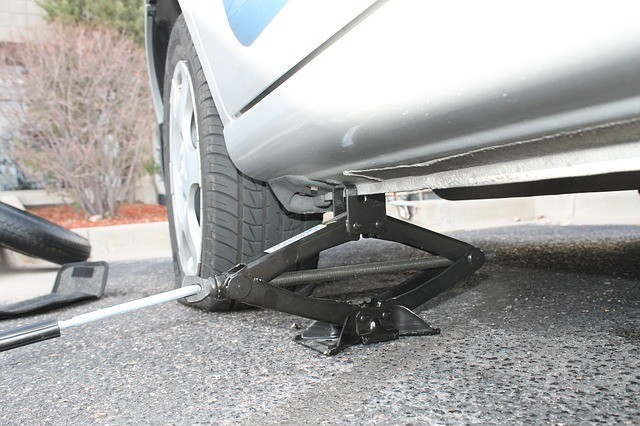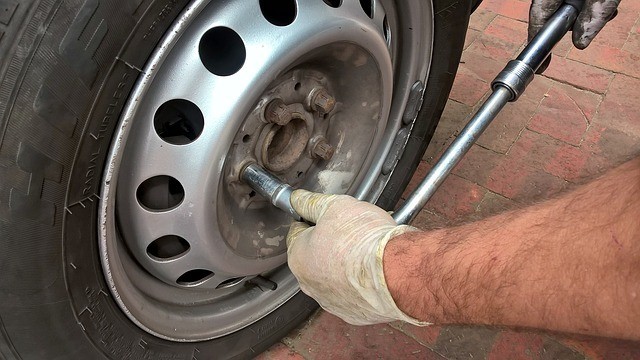My neighbor is a single woman who often goes out on the road by herself in her RV. I’ve often wondered what would happen if she had a flat tire while traveling. And worse, what if the lug nuts on one of her wheels were bad. Would she know how to break a lug nut off the RV tire?
So, I did a little research to find the answer. And I have to tell you — it’s not cut and dried. While it is possible to learn how to break a lug nut off, it’s not always possible to actually do it yourself. But if it were me, I’d certainly try to before calling in the pros.
RVs Get Flat Tires, Too

image via: pixabay
People tend to think that RVs are invincible because they’re so large. But the truth is, RVs get flat tires just like any other vehicle. And when they do, it’s not always easy to change the tire. And if you have to figure out how to break a lug nut off, it’s even trickier.
But before we talk about that, let’s look at some things you’ll have to consider if you get a flat tire in an RV.
Special considerations with RV flat tires
Getting a flat tire in an RV is a lot different than the average automobile flat. Here are some of the things you’ll need to keep in mind when trying to repair a flat tire on an RV.
The question of space
Everyone knows that you have to pull to the side of the road when you have a flat tire, but when you’re driving an RV, you need to find a spot that’s large enough to hold your vehicle. Look for an area that is big and flat. Remember, jacking up your RV isn’t as easy as a car, and you need a lot of space and level ground to accomplish the job.
Be sure to put safety cones or flashers behind the RV so others can see that you’re broken down and avoid hitting you.
Then equipment
A car jack won’t lift your RV. Instead, the job of changing an RV tire is more complicated. Start with a hydraulic bottle jack and some jack stands to support your axel and wheels. And even if you’re on level ground, you should cut some 1 x 1 square pieces from 3/4 exterior plywood and put it under the jack and jack stands.
Obviously, this is easier to do in advance, and keep in the RV for these sorts of emergencies.
If you’re not on level ground or have any reason to believe that it’s not safe for you to change your RV tire, call a tow truck. The extra expense is well worth the risk of injury and damage to your RV.
Dealing with realities
Unlike a car tire, RV tires are heavy, and you need to make sure you’ve got what it takes to lift one. Most of them weigh in at 35 to 100 pounds. That neighbor I told you about who takes off in her RV alone? Some RV tires weigh more than she does.
How to Change an RV Tire

image via: pixabay
Now that you understand what changing an RV tire entails let’s take a look at how to do it. The following explains how to change an RV tire, but we won’t talk about how to break off a lug nut until the next section.
First things first
Your first step is to use the hydraulic jack and jack stands to raise your RV enough so that you can spin the tires. Don’t worry about raising it higher than that because there is no reason to and it will only increase the risk of something going wrong.
Now down to business
If you’re lucky, you won’t have to learn how to break a lug nut off because they’ll come right off. Keep in mind that when removing lug nuts on an RV, every model is different. Some require the use of a special tool such as a lug nut cover remover to remove the piece of metal covering the nut.
If your RV model doesn’t have covers on the nuts, go ahead and use a tire wrench to remove them.
The finishing move
All that’s left is to pull off the bad tire and replace it with a new one. Once you’ve used the tire wrench to put the lug nuts back in place, carefully lower the jack and jack stands. Put away all your equipment, and you’re ready to go.
What if the Lug Nuts Won’t Come Off?

image via: pixabay
Now that you understand what changing an RV tire entails let’s take a look at how to do it. The following explains how to change an RV tire, but we won’t talk about how to break off a lug nut until the next section.
3 Reasons Your Lug Nut Might Be Stuck
Take a look at them
Sometimes corrosion sets in and “glues” the lug nuts in. This happens in areas where things are more likely to rust like beach locations. Some cleaners can also cause rust, and if the steel has even a slight crack in it, rust will set in and corrode the lug nut.
Invisible from the outside
When a lug nut gets overtightened, it can cause it to strip. That’s why it’s important to tighten them just to the manufacturers recommendations and never over tighten.
Talking about angles
Rounded off lug nuts are also the result of overzealous tightening. It causes the metal around the nut to round down, which makes it very difficult to remove when you need to.
How to Break a Lug Nut Off
If you find yourself in this position, you have a few options when you want to learn how to break a lug nut off on an RV tire. Here’s what you need to know.
Check for special circumstances
Not all RVs have visible lug nuts. Some RV manufacturers hide lug nuts underneath lug nut covers. Before you panic, make sure you’re not looking at a cover instead of a lug nut.
“Greasing the wheels”
If rust is the reason your lug nuts are stuck, try using a penetrating oil like PB Blaster. This oil gets down into the cracks and can loosen up the rust that is holding the nut in place.
Convince it, bluntly
To loosen the bond that’s holding the lug nut in place, you can use blunt force to try and free it. Start by hitting the nut in the center of the head. If that doesn’t work, hit it in reverse and then forward a few times. If this doesn’t loosen the bolt, move on to another one of the suggestions.
Try Science!
You can heat up the lug nut, which will make it expand and then contract when it cools down. This might be enough to break the bond that’s holding it in. Another option is to heat the hole the nut is in, and when it expands, try to unthread the nut.
Sometimes it’s about finesse
By rocking the lug nut back and forth, you may break the seal that’s holding it. As you rock it, spray some penetrant in it so it can begin to break away the rust in the cracks. This method takes time and patience, but it works.
Power tools
If you’ve tried a few other methods and can’t figure out how to break a lug nut off on your RV, you can try drilling it. To do it, drill a hole in the center of the lug nut. This will heat the nut, and then as it cools, it will begin to contract. Because there is a hole in the middle of it, it can contract even more, which may be enough to allow you to remove the bolt.
If it doesn’t work, try replacing the drill bit with a larger one and try again.
Play with fire
If the head of the bolt is stripped or missing, try welding a washer and a slightly larger bolt to the lug nut. Once you’ve filled in the weld and allowed it to cool, you should be able to use a socket to remove it.
Tools matter
If you can get a pipe wrench around the nut, tighten it up and crack it. Sometimes this is all it takes when you want to know how to break a lug nut off from an RV tire.
No seriously, they matter!
Bolt extractors are specialty tools that require you to drill a hole in the nut and then they “grab” inside that hole to help release the nut. Some of the tools work well, and some cause more problems than they solve. For instance, if they break off inside the nut, you will probably never get them out.
If all else fails
If you’ve tried all of the above and still can’t figure out how to break a lug nut off, it’s time to call in the pros. Call your Triple AAA or closest repair shop that works on RVs and put it to rest.
After all, you did your best.
Prevention Tips to Avoid RV Flat Tires
Prevention is key when it comes to avoiding flat tires on the road, and there are several things you can do to ensure you will never have to learn how to break a lug nut off on an RV tire.
- Check your tire threads regularly and replace them when they start showing wear or every five years
- Know your tire inflation levels and keep them steady
- Stay within the recommended weight limit of your RV and don’t overload it
Did You Learn How to Break a Lug Nut Off on an RV?
Hopefully, you’re reading this article for the knowledge and not because you need to know how to break a lug nut off from an RV right now. But if you do, read the suggestions calmly and try your best. And remember if you can’t loosen the RV lug nut, you always have the option of calling a professional.
Have you ever had to learn how to break a lug nut off from an RV? If so, we would love to hear about your experience in the comments below!